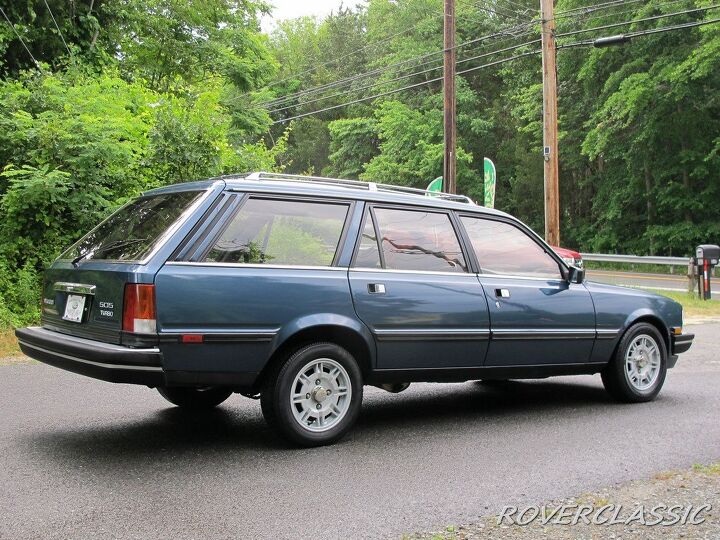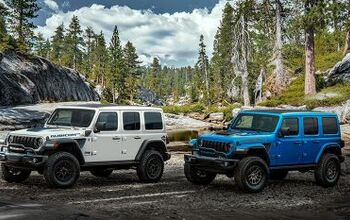Rare Rides: A 1986 Peugeot 505 Wagon - French and Turbocharged

Rare Rides has featured a couple of Peugeot cars in previous entries. From the Nineties was the sporty front-drive 405 Mi16, which had the honor of being the last Peugeot model sold in the United States.
We also featured a Seventies Peugeot: The graceful 504, which was predecessor to today’s 505.
As the Seventies drew to a close, the 504 was showing its age. In production since 1968, 504 carried out its duties as Peugeot’s large family car offering. Only one car stood above it in the lineup: The executive class 604, which was based on the 504.
Though the 504 would continue in production in France through 1983, the successor 505 debuted in May of 1979. Based on the 504, the 505 was intended to be a more modern vehicle that carried off the same sturdy, reliable character as its parent. The 505’s styling was much more boxy than its predecessor, the result of a collaboration between the Italian firm Pininfarina and Peugeot’s own designers. They drew inspiration from the new 305 sedan’s styling, which was also penned by Pininfarina.
Peugeot hired another famous name for the interior: Paul Bracq. The French-born designer had substantial experience in automotive interiors, styling classics like the Mercedes 600, 230SL, the W108, and the W114 coupe. He also designed the TGV train before eventually becoming design director at BMW, where he worked on the all-new 7 Series.
Initially the only body style available was a four-door sedan, as work continued to prepare the wagon version for its 1982 debut. Not simply hatch and cargo area rework, the 505 wagon had a longer 114-inch wheelbase, which was six inches more than the sedan. The standard wagon was called Break in its home market, while the real family-hauling eight-seat version was known as Familiale. Perhaps unexpectedly, all three rows of the Familiale faced forward. As U.S. customers were not too familiale-er with French nomenclature, the name was adapted to SW8, for Station Wagon, 8 seats.
Other adaptations for North American consumers included a relocated fuel tank (which was filled from the right instead of the left), revised quad lamps at the front, and market-specific tail lamps prior to 1986. The headlights were eventually swapped out with composite versions when U.S. regulation caught up to the times. Engines offered in North America were a 2.0-liter inline-four, a 2.3-liter diesel (with optional turbo after 1981), and for 1985 onward, a gasoline-powered 505 Turbo model, which featured a 142-horsepower 2.2-liter four developed by Chrysler-Simca.
Peugeot refined the Turbo model over the years, and eventually it reached a peak power output of 180 horses. North America was the only market to receive such a turbo wagon. Globally, the 505 used three- and four-speed automatics, along with four- and five-speed manuals.
Finding the North American market unsustainable, Peugeot left in the middle of 1991 and went back home. The 504 persisted in European production through 1992, in Argentina through 1995, and in China it continued unabated until 1997. The last-ever rear-drive Peugeot, the 505’s official replacement was the front-drive 405 that started production in 1987.
Today’s Rare Ride is loaded up with leather (that desperately needs a detail) and an automatic transmission. In great condition and with 131,000 miles, the 505 asks $6,300.
[Images: seller]

Interested in lots of cars and their various historical contexts. Started writing articles for TTAC in late 2016, when my first posts were QOTDs. From there I started a few new series like Rare Rides, Buy/Drive/Burn, Abandoned History, and most recently Rare Rides Icons. Operating from a home base in Cincinnati, Ohio, a relative auto journalist dead zone. Many of my articles are prompted by something I'll see on social media that sparks my interest and causes me to research. Finding articles and information from the early days of the internet and beyond that covers the little details lost to time: trim packages, color and wheel choices, interior fabrics. Beyond those, I'm fascinated by automotive industry experiments, both failures and successes. Lately I've taken an interest in AI, and generating "what if" type images for car models long dead. Reincarnating a modern Toyota Paseo, Lincoln Mark IX, or Isuzu Trooper through a text prompt is fun. Fun to post them on Twitter too, and watch people overreact. To that end, the social media I use most is Twitter, @CoreyLewis86. I also contribute pieces for Forbes Wheels and Forbes Home.
More by Corey Lewis
Latest Car Reviews
Read moreLatest Product Reviews
Read moreRecent Comments
- Jalop1991 In a manner similar to PHEV being the correct answer, I declare RPVs to be the correct answer here.We're doing it with certain aircraft; why not with cars on the ground, using hardware and tools like Telsa's "FSD" or GM's "SuperCruise" as the base?Take the local Uber driver out of the car, and put him in a professional centralized environment from where he drives me around. The system and the individual car can have awareness as well as gates, but he's responsible for the driving.Put the tech into my car, and let me buy it as needed. I need someone else to drive me home; hit the button and voila, I've hired a driver for the moment. I don't want to drive 11 hours to my vacation spot; hire the remote pilot for that. When I get there, I have my car and he's still at his normal location, piloting cars for other people.The system would allow for driver rest period, like what's required for truckers, so I might end up with multiple people driving me to the coast. I don't care. And they don't have to be physically with me, therefore they can be way cheaper.Charge taxi-type per-mile rates. For long drives, offer per-trip rates. Offer subscriptions, including miles/hours. Whatever.(And for grins, dress the remote pilots all as Johnnie.)Start this out with big rigs. Take the trucker away from the long haul driving, and let him be there for emergencies and the short haul parts of the trip.And in a manner similar to PHEVs being discredited, I fully expect to be razzed for this brilliant idea (not unlike how Alan Kay wasn't recognized until many many years later for his Dynabook vision).
- B-BodyBuick84 Not afraid of AV's as I highly doubt they will ever be %100 viable for our roads. Stop-and-go downtown city or rush hour highway traffic? I can see that, but otherwise there's simply too many variables. Bad weather conditions, faded road lines or markings, reflective surfaces with glare, etc. There's also the issue of cultural norms. About a decade ago there was actually an online test called 'The Morality Machine' one could do online where you were in control of an AV and choose what action to take when a crash was inevitable. I think something like 2.5 million people across the world participated? For example, do you hit and most likely kill the elderly couple strolling across the crosswalk or crash the vehicle into a cement barrier and almost certainly cause the death of the vehicle occupants? What if it's a parent and child? In N. America 98% of people choose to hit the elderly couple and save themselves while in Asia, the exact opposite happened where 98% choose to hit the parent and child. Why? Cultural differences. Asia puts a lot of emphasis on respecting their elderly while N. America has a culture of 'save/ protect the children'. Are these AV's going to respect that culture? Is a VW Jetta or Buick Envision AV going to have different programming depending on whether it's sold in Canada or Taiwan? how's that going to effect legislation and legal battles when a crash inevitibly does happen? These are the true barriers to mass AV adoption, and in the 10 years since that test came out, there has been zero answers or progress on this matter. So no, I'm not afraid of AV's simply because with the exception of a few specific situations, most avenues are going to prove to be a dead-end for automakers.
- Mike Bradley Autonomous cars were developed in Silicon Valley. For new products there, the standard business plan is to put a barely-functioning product on the market right away and wait for the early-adopter customers to find the flaws. That's exactly what's happened. Detroit's plan is pretty much the opposite, but Detroit isn't developing this product. That's why dealers, for instance, haven't been trained in the cars.
- Dartman https://apnews.com/article/artificial-intelligence-fighter-jets-air-force-6a1100c96a73ca9b7f41cbd6a2753fdaAutonomous/Ai is here now. The question is implementation and acceptance.
- FreedMike If Dodge were smart - and I don't think they are - they'd spend their money refreshing and reworking the Durango (which I think is entering model year 3,221), versus going down the same "stuff 'em full of motor and give 'em cool new paint options" path. That's the approach they used with the Charger and Challenger, and both those models are dead. The Durango is still a strong product in a strong market; why not keep it fresher?








































Comments
Join the conversation
I really like the blue interior. I miss the choice of interior colors. It is getting to the point where even tan and gray interiors are getting scarce with the only choice being black.
My wife's aunt who lived in Atlanta had a Peugeot 505 sedan as a daily driver in the early 2000s. When she dropped our family off at Hartsfield for our flight home, I recall asking her to ring me first if she ever considered selling it, but alas the last I heard something mechanical went bad (details unknown) and she sold it to the garage that had regularly serviced it. That said, my exposure to that car got me interested in Peugeots in general, and I soon subscribed to a Peugeot mailing list that featured one fantastic fellow, known as Peugeot Pete (RIP), who was quite the expert with a heart of gold, regularly dispensing wisdom about all things automotive and Peugeots in particular. He even had parts details on microfiche and would look anything up to help someone in need. Pete was the glue that held that community together and demonstrated the benefits of online communities for people with niche interests, especially in the days before social media. My last Peugeot story: my wife and I rented a 208 on our UK trip last year (manual transmission, of course): it was the perfect car for that environment--we stayed in Hayes (West London) and drove the hell out of it: did a trip within a trip to Edinburgh (stayed overnight), then hit a beach in Wales on the way back the following day. Did day trips on the side to Brighton and Oxford. Practical hatchback with great handling and a decent feature level; it was narrow enough to handle some physically tight driving situations, both in urban areas (though we didn't drive in central London) as well as a stereotypical one-lane hedgerow driving path (it'd be generous to call it a road), just south of Stonehenge. If that 208 were sold in US I'd not hesitate to buy it. I was sad when we had to turn it in at the end of the trip, and by then we were reasonably comfortable with driving on the other side of the road whilst sitting on the other side of the car and shifting with the other hand.